smacdonald
Well-Known Member
At the end of October I went over to the TDWG (the international organisation for biodiversity information standards) 2008 conference. The conference was a great success and a fantastic networking opportunity. There was, however, a distinct lack of reptiles at the conference. So at the end of the week I went down to revisit Dryandra Woodland.
Now, Dryandra isn't all about reptiles. Not many people know this, but there are in fact some mammals inhabiting this mosaic of remnant wandoo vegetation. The most commonly seen diurnal mammals are the macropods, such as the western grey kangaroo (Macropus fulliginosus), and the echidna (Tachyglossus aculeatus). I saw so many echidnas at Dryandra over the course of a week, I'm surprised the local termite population hasn't gone extinct. I wonder if a termite extinction would have an impact on any other fauna at Dryandra...

Western grey kangaroo (Macropus fulliginosus).
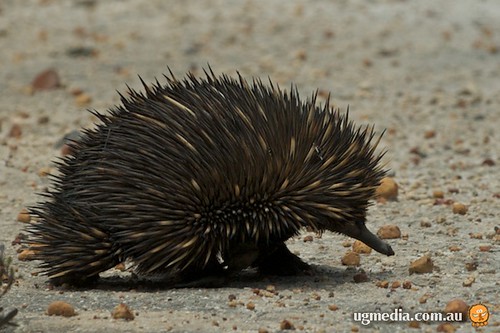
Echidna (Tachyglossus aculeatus).

Echidna (Tachyglossus aculeatus).

Echidna (Tachyglossus aculeatus).
The most commonly encountered nocturnal mammals are probably the brushtail possums (Trichosurus vulpecula). They're so common, in fact, that I kept putting off photographing one until the last night, a night on which I (of course) found none. The not-so-commonly encountered mammals of Dryandra include brush-tailed bettongs or woylies (Bettongia penicillata), bilbies (Macrotis lagotis) and red-tailed phascogales (Phascogale calura).

Brush-tailed bettong (Bettongia penicillata) at Karakamia Sanctuary, Western Australia.
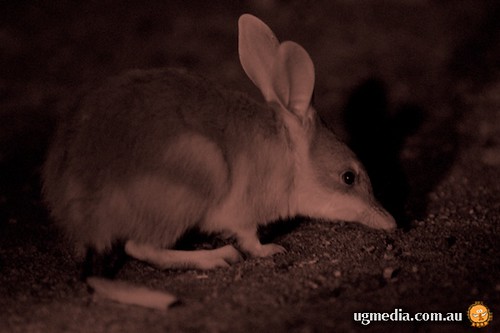
Bilby (Lagotis macrotis) at Barna-Mia Sanctuary, Western Australia.
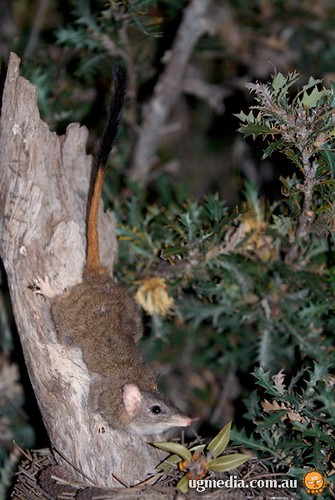
Red-tailed phascogale (Phascogale calura).
But of course, I was there for animals of the scaled variety, and I wasn't disappointed. A (sub)species I was really keen to see was the south-western carpet python (Morelia spilota imbricata). A fellow visitor alerted me to a python sunning itself on a log not far away from where I was staying. I dashed (well, as much as one can dash with 16 kilograms of camera gear on ones back) down to the log and, sure enough, there was a carpet snake minding its own business. Exciting stuff! The fact that it was a scrawny, ugly, scarred specimen didn't worry me (much).
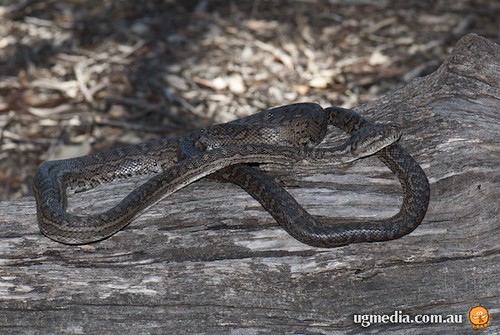
South-western carpet python (Morelia spilota imbricata).
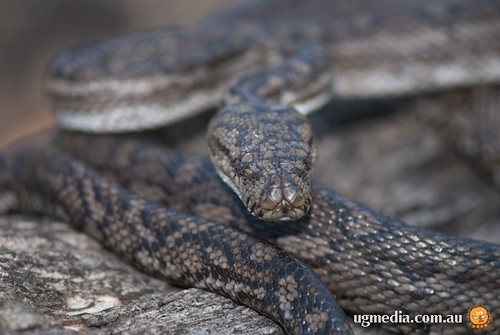
South-western carpet python (Morelia spilota imbricata).

The log in which a south-western carpet python (Morelia spilota imbricata) was sheltering.
Shingleback skinks (Tiliqua rugosa) were often encountered (sometimes violently) on the roads.
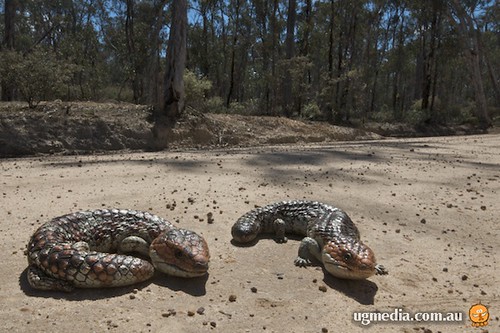
Shingleback skinks (Tiliqua rugosa) at Dryandra Woodland, Western Australia.
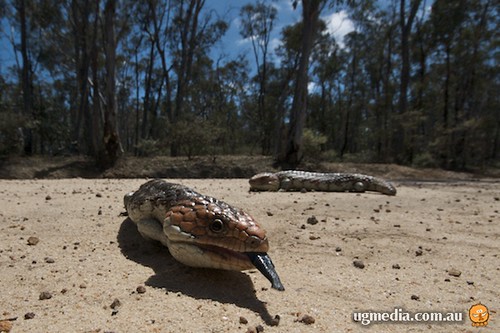
Shingleback skinks (Tiliqua rugosa) at Dryandra Woodland, Western Australia.

Shingleback skinks (Tiliqua rugosa) at Dryandra Woodland, Western Australia.
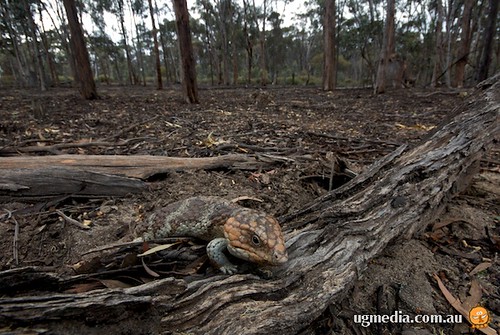
Shingleback skinks (Tiliqua rugosa) at Dryandra Woodland, Western Australia.
I saw a King's skink (Egernia kingii) poking around the barbecue area, possibly looking for some left over bacon from that morning's breakfast. He obviously didn't like the look of me (who could blame him) and, as he sought refuge inside the barbecue when I approached, I could only manage to get a pic of his tail end.
When the sun was out, so too were the little skinks. I saw (but didn't photograph) a Morethia species (probably M. obscura or M. butleri) and plenty of Cryptoblepharus buchananii skinks.
But of course, there's one animal that makes Dryandra <strong>really</strong> famous. The animal that draws people to this out-of-the way park. An iconic, charismatic species that enchants and enthrals all who see it: Lerista distinguenda.
I mucked around with some timelapse photography when I was out there, capturing an hour-long sequence of a sunset. It doesn't want to embed (edit: OK, so now it wants to embed itself), so here's the link:
YouTube - Sunset time-lapse
Now, Dryandra isn't all about reptiles. Not many people know this, but there are in fact some mammals inhabiting this mosaic of remnant wandoo vegetation. The most commonly seen diurnal mammals are the macropods, such as the western grey kangaroo (Macropus fulliginosus), and the echidna (Tachyglossus aculeatus). I saw so many echidnas at Dryandra over the course of a week, I'm surprised the local termite population hasn't gone extinct. I wonder if a termite extinction would have an impact on any other fauna at Dryandra...

Western grey kangaroo (Macropus fulliginosus).

Echidna (Tachyglossus aculeatus).

Echidna (Tachyglossus aculeatus).

Echidna (Tachyglossus aculeatus).
The most commonly encountered nocturnal mammals are probably the brushtail possums (Trichosurus vulpecula). They're so common, in fact, that I kept putting off photographing one until the last night, a night on which I (of course) found none. The not-so-commonly encountered mammals of Dryandra include brush-tailed bettongs or woylies (Bettongia penicillata), bilbies (Macrotis lagotis) and red-tailed phascogales (Phascogale calura).

Brush-tailed bettong (Bettongia penicillata) at Karakamia Sanctuary, Western Australia.

Bilby (Lagotis macrotis) at Barna-Mia Sanctuary, Western Australia.

Red-tailed phascogale (Phascogale calura).
But of course, I was there for animals of the scaled variety, and I wasn't disappointed. A (sub)species I was really keen to see was the south-western carpet python (Morelia spilota imbricata). A fellow visitor alerted me to a python sunning itself on a log not far away from where I was staying. I dashed (well, as much as one can dash with 16 kilograms of camera gear on ones back) down to the log and, sure enough, there was a carpet snake minding its own business. Exciting stuff! The fact that it was a scrawny, ugly, scarred specimen didn't worry me (much).

South-western carpet python (Morelia spilota imbricata).

South-western carpet python (Morelia spilota imbricata).

The log in which a south-western carpet python (Morelia spilota imbricata) was sheltering.
Shingleback skinks (Tiliqua rugosa) were often encountered (sometimes violently) on the roads.

Shingleback skinks (Tiliqua rugosa) at Dryandra Woodland, Western Australia.

Shingleback skinks (Tiliqua rugosa) at Dryandra Woodland, Western Australia.

Shingleback skinks (Tiliqua rugosa) at Dryandra Woodland, Western Australia.

Shingleback skinks (Tiliqua rugosa) at Dryandra Woodland, Western Australia.
I saw a King's skink (Egernia kingii) poking around the barbecue area, possibly looking for some left over bacon from that morning's breakfast. He obviously didn't like the look of me (who could blame him) and, as he sought refuge inside the barbecue when I approached, I could only manage to get a pic of his tail end.
When the sun was out, so too were the little skinks. I saw (but didn't photograph) a Morethia species (probably M. obscura or M. butleri) and plenty of Cryptoblepharus buchananii skinks.
But of course, there's one animal that makes Dryandra <strong>really</strong> famous. The animal that draws people to this out-of-the way park. An iconic, charismatic species that enchants and enthrals all who see it: Lerista distinguenda.
I mucked around with some timelapse photography when I was out there, capturing an hour-long sequence of a sunset. It doesn't want to embed (edit: OK, so now it wants to embed itself), so here's the link:
YouTube - Sunset time-lapse
Last edited:








